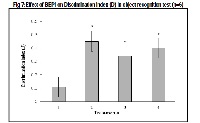Nootropic activity of butanolic extract Passiflora ncarnata leaves
Keywords:
Nootropic, elevated plus maze test, object recognition tesAbstract
Alzheimer’s disease (AD) is the most common cause of dementia among people of age 65 and older. Nootropics are a class of psychotropic drugs that enhance learning, acquisition and reverse learning impairments in experimental animals. Numerous plants have been used to treat cognitive disorders in the traditional medicine. Passiflora incarnata Linn (Family: Passifloraceae) has been widely used in traditional medicine as sedative, anxiolytic, antispasmodic, analgesic, anticonvulsant, and wormicidal. Till date there are no reports on nootropic activity of Passiflora incarnata. Hence, in the present study, nootropic activity of n-butanol extract of P. incarnata leaves (BEPI) was studied using elevated plus maze and object recognition test. The results of the study signified that n-butanol extract of P. incarnata leaves containing flavonoids possessed nootropic activity indicated by shortening of transfer latency (TL) and an increase in discrimination index. Pretreatment with BEPI protected the animals from memory deficits produced by scopolamine. The results of present study confirmed that nootropic effect of BEPI is mediated through facilitation of brain cholinergic neurotransmission and major phytoconstituent like flavonoids, alkaloids and phenolic compounds may be responsible for nootropic effect of P. incarnata
References
. Ingole SR, Rajput SK, Sharma SS,
Cognition Enhancers: Current
Strategies and Future Perspectives.
CRIPS. 2008; 9(3): 42-48.
. Vas CJ, Rajkumar S, Tanyakitpisal P,
Chandra V. What is dementia? What
is Alzheimer’s disease? In Alzheimer's
disease: The brain killer, World Health
Organization-South-East Asia, 2001,
p, 16-18.
. Une HD, Pal SC, Kasture VS, Kasture
SB. Phytochemical constituents and
pharmacological profile of Albizzia
lebbeck. J Nat Remed. 2001; 1(1): 1-
. Jain NN, Ohal CC, Shroff SK,
Bhutada RH, Somani RS, Kasture VS.
Clitoria ternatea and CNS. Pharmacol
Biochem Behav. 2003; 75: 529-536.
. Iyer MR, Pal SC, Kasture VS, Kasture
SB. Effect of Lowsonia inermis on
memory and behavior mediated via
monoamine neurotransmitters. Indian
J Pharmacol. 1998; 30(3):181-185.
. Raskind MA, Peskind ER, Wessel T,
Yuan W, Allen FH, Aronsom SM.
Galanthamine in AD: a 6 month
randomized, placebo-controlled trial
with a 6 month extension. Neurology.
; 54(12):2261-8.
. Soulimani R, Younos C, Jarmouni S,
Bousta D, Misslin R, Mortier F,
Behavioral effects of P. incarnata L.
and its indole alkaloid and flavonoid
derivatives and maltol in the mouse. J
Ethnopharmacol. 1997;57 :11-20.
. Dhawan K, Kumar S, Sharma A.
Passiflora: a review update. J
Ethnopharmacol. 2004; 94: 1-23.
. Kulkarni KS, Kasture SB, Mengi SA.
Efficacy study of Prunus amygdalus
(almond) nuts in scopolamine-induced
amnesia in rats. Indian J Pharmacol.
; 42(3): 168-173.
. Trease GE, Evans MC, Textbook of
pharmacognosy, 6th ed. London:
Balliere Tindall,; 2002.p, 57.
. Marinova D, Ribarova F, Atanassova
M. Total phenolics and total flavonoids
in bulgarian fruits and vegetables. J
University of Chemical Technology
and Metallurgy. 2005; 40(3):255-260.
. Shamsa F, Monsef HR, Ghamooshi
R, Verdian R, Mohammad R.
Spectrophotometric Determination of
Total Alkaloids in Peganum harmala
L. using Bromocresol Green. Res J
Phytochem. 2007;1 (2): 79-82.
. Lorke D. A new approach to practical
acute toxicity testing. Arch Toxicol.
; 54 (4): 275-287.
. Lister RG.The amnesic action of
benzodiazepines in man. Neurosci
Biobehav Rev. 1985; 9 (1):87-94.
. Bartolini L, Cesamenti F, Pepeu G.
Aniracetam restore object recognition
impaired by age, scopolamine and
nucleus basalus lesions. Pharmacol
Biochem Behav. 1996; 53 (2): 277-
. Chintawar SD, Somani RS, Kasture
VS, Kasture SB. Nootropic activity of
Albizzia lebbeck in mice. J
Ethnopharmacol. 2002; 81 (3): 299-
. Hollander E, Mohs RC, Davis KL.
Cholinergic approaches to the
treatment of Alzheimer's disease. Br
Med Bull. 1986; 42 (1): 97-100.
. Joshi H, Parle M. Pharmacological
evidences for the antiamnesic effects
of Desmodium gangeticum in mice,
Iranian J Pharm Res. 2007; 6(3):
-207.
. Hammer R, Berrie CP, Birdsall JM,
Burgen SV. Hulme EC. Pirenzepine
distinguishes between different
subclasses of muscarinic receptors.
Nature (Land). 1980; 283: 90-92.
. Sumalatha G, Baburao C, Mukkanti K.
Evaluaton of nootropic potential and in
vitro antioxidant activity of aqueous
extract of Asparagus racemosus in
rats. Inter J Pharm Res and Dev.
; 3 (6): 184-191.
. Zhang-Jin Z. Therapeutic effects of
herbal extracts and constituents in
animal models of psychiatric
disorders. Life Sciences. 2004; 75
(14): 1659-99



